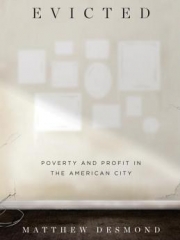Evicted by Matthew Desmond
Per the go-somewhere-read-about-it rule, I was trying to find a book about San Francisco. While there are an infinite number of books on startups / big tech, none of them really focus on the city’s character. What I kept coming back to was the housing situation. Other than tech, housing – or the lack thereof – is the defining feature of present day SF. How did we end up with blocks of million-dollar apartments with homeless people sleeping outside the front door? I don’t know the facts of the housing crisis, and I definitely don’t know how to solve it. For me, the expensive housing part is inevitable. Yes, based on the limited data I’ve looked at, SF (and the bay area) is not building enough new homes, but sky high property prices are unavoidable for job meccas. Ultimately, plenty of people are willing to pay these prices. So, to me, the more pressing problem is homelessness. Many cities are super expensive but do not have such an egregious homelessness problem. I wanted to learn more about how homelessness happens, and reading this book was a start.
1) Between 2009 and 2011, 1 in 8 renters in Milwaukee were forced to move at least once.
Even though this was during the “Great Recession”, this number is still crazy high and not just specific to Milwaukee. Housing is a basic need. Once people are evicted, how many layers of safety net are there before they end up on the streets?
2) Every year, $6 billion worth of power is stolen in America.
When people can barely make rent, they have to choose between not having electricity or stealing it.
3) The Fair Housing Act of 1968 made housing discrimination illegal.
This was only 50 years ago. We’ve come so far yet we’re still so far. It’s also not just race. Renters have to lie about not having kids so that landlords won’t find someone else.
4) Knowing that eviction is inevitable, people would stop paying rent to save money for the next place.
The thing that stood out the most in this book was the vicious cycle that evictees enter. Once you get evicted, it becomes harder to find a place because landlords want clean records. Stability is gone because you have to spend time looking for a new place, so you may miss a welfare appointment, which means you get your benefits cut. And now you don’t have money to pay rent, and it keeps going.
5) Blacks had higher rents than whites at similar housing as late as the 1960s.
Discrimination (overt or subtle) meant that the poor did not necessarily pay lower rent. Rents in slums were high because the people there had nowhere else to go. Even today, there is a de facto price floor, and the worst housing is not much cheaper than decent housing.
6) In Milwaukee, 70% of tenants called to eviction court did not show up.
75% were black, and of these, 75% were women. The author put it succinctly: “Poor black men were locked up. Poor black women were locked out.”
7) Landlords cannot garnish the first $1K.
Reading up more on this, it looks like landlords can garnish 25% of pay but must leave the tenant with at least 30x the minimal federal hourly wage.
8) Renters with housing vouchers pay up to 30% of their income to rent, and the program covers the rest.
Housing vouchers were an attempt at a free market solution. Often times, landlords would overcharge because they know the tenant is only paying a portion. This means that the program is basically enriching landlords. It’s telling that the National Association of Realtors supports the voucher program (vs. public housing projects). In 2013, 17% of poor renters received a government subsidy, vs 15% who lived in public housing.
9) The poor don’t identify with the poor, and thus collective action doesn’t happen.
This is my interpretation of the author’s take, and I agree. I think this is a major reason why economic divides are stronger than racial or other types of divides. People organize groups to address specific racial issues, but who is going to join a club for poor people?
10) In housing courts, 90% of landlords are represented by an attorney. 10% of tenants are.
Maybe lawyers are a necessary evil.
This book follows several people – both landlords and tenants – to tell a story about how evictions work. It was really eye-opening and scary to see how vulnerable people are to the system. For the most part, everyone is just trying to live their lives. Tenants want to pay rent when they can, and landlords don’t want to evict tenants unless it’s necessary. But people always fall through the cracks, whether it’s bad luck, drugs, or the poor design of the system. Then it’s up to family, friends, and the government to save them, even though a family death, or an unexpected baby, or a lost welfare check may have caused the eviction in the first place. Homelessness is a symptom that one or many parts of this machine has malfunctioned.
